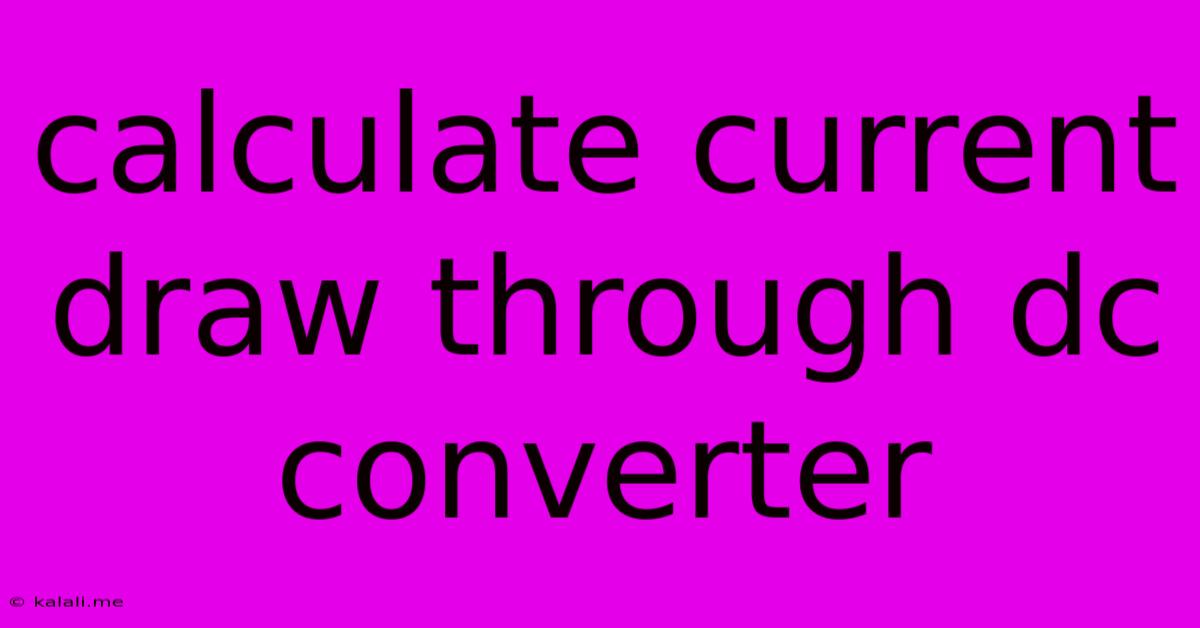Calculate Current Draw Through Dc Converter
Kalali
May 29, 2025 · 3 min read

Table of Contents
Calculating Current Draw Through a DC-DC Converter: A Comprehensive Guide
Meta Description: Learn how to accurately calculate the current draw of a DC-DC converter, considering efficiency, input voltage, and output power. This guide covers essential formulas and practical considerations for various converter types.
Understanding the current draw of a DC-DC converter is crucial for power supply design, battery life estimation, and overall system efficiency. This article will walk you through the process of calculating this critical parameter, considering various factors and offering practical tips for different converter topologies. We'll delve into the equations, explain the variables, and highlight common pitfalls to avoid.
Understanding the Basics: Input and Output Power
The foundation of current draw calculation lies in the relationship between input and output power. A DC-DC converter transforms a DC voltage from one level to another. While energy is conserved (ignoring minor losses), the current changes inversely proportional to the voltage change. This relationship is governed by the fundamental principle of power conservation:
Input Power (Pin) ≈ Output Power (Pout)
This approximation holds true if we neglect the converter's losses. In reality, no converter is perfectly efficient; some energy is lost as heat. This efficiency (η) needs to be factored into our calculations.
The Key Formula: Calculating Input Current
To calculate the input current (Iin), we need the following information:
- Output Power (Pout): This is the power delivered by the converter to the load (measured in Watts). It's calculated as
Pout = Vout * Iout, whereVoutis the output voltage andIoutis the output current. - Input Voltage (Vin): This is the voltage supplied to the converter (measured in Volts).
- Converter Efficiency (η): This represents the percentage of input power converted into useful output power. It's usually expressed as a decimal (e.g., 90% efficiency is 0.9). Datasheets for specific converters will provide this information.
The formula for calculating the input current is:
Iin = Pout / (Vin * η)
Example: Let's say we have a DC-DC converter with:
Pout= 10WVin= 12Vη= 0.85 (85% efficiency)
Then, Iin = 10W / (12V * 0.85) ≈ 0.98A
Accounting for Converter Losses and Other Factors
The above formula provides a reasonable estimate, but several factors can influence the actual current draw:
- Switching Frequency: Higher switching frequencies often lead to slightly higher losses.
- Load Current Variations: The current draw fluctuates depending on the load's demand. The calculation above assumes a constant load.
- Temperature: Temperature affects the converter's efficiency; higher temperatures generally lead to lower efficiency.
- Input Voltage Variations: Fluctuations in input voltage will affect the current draw. The calculation assumes a stable input voltage.
Different DC-DC Converter Topologies
Different DC-DC converter topologies (e.g., buck, boost, buck-boost) have varying efficiency characteristics. The efficiency value (η) used in the calculation should always be taken from the specific converter's datasheet under the relevant operating conditions.
Practical Considerations and Troubleshooting
- Always consult the datasheet: The datasheet is the ultimate source of truth for your specific converter. It provides crucial information on efficiency curves, input current limits, and other relevant specifications.
- Measure the current: The calculated value is an estimate. For precise measurement, use a multimeter to directly measure the input current.
- Consider peak current: The average current might be acceptable, but the peak current (during transient periods) can be significantly higher and needs to be accounted for when choosing components.
By carefully considering these factors and utilizing the provided formula, you can accurately estimate and measure the current draw of your DC-DC converter, ensuring the proper design and operation of your power system. Remember to always prioritize safety and consult relevant datasheets for accurate information.
Latest Posts
Latest Posts
-
How Do You Restart A Canon Powershot Camera
May 30, 2025
-
Can I Check Out Of A Hotel Early
May 30, 2025
-
Convert State Plane Coordinates To Latitude And Longitude
May 30, 2025
-
We Are Defently Are Going To Get Along
May 30, 2025
-
3 Way Motion Sensor Switch Wiring Diagram
May 30, 2025
Related Post
Thank you for visiting our website which covers about Calculate Current Draw Through Dc Converter . We hope the information provided has been useful to you. Feel free to contact us if you have any questions or need further assistance. See you next time and don't miss to bookmark.